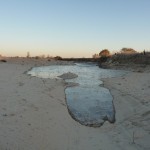
October 1, 2009, water flowed down a sandy segment of the San Joaquin River that had run dry for more than sixty years. Though it was a major historic event, it was noted mostly by a small group of insiders who follow water policy like an investor follows the stock market. Almost three years later, Valley citizens are scarcely aware of the escalating battle over California’s second largest river, but the recent uproar over a proposed sale of water to San Francisco by the Modesto Irrigation District (MID) may auger a seismic shift in public attention to water issues.
Initially presented as a piddling 2,000 acre-foot per year mini-sale, the MID proposal was supported by the usual proponents of business as usual, including the Modesto Bee and the majority of the MID Board of Directors. But as word of the sale spread via email and social media, alarm bells began clanging throughout the region.
Almond grower and cattle man Larry Byrd, an opponent of the water sale, ran for and won a seat on the MID Board of Directors. Stanislaus County Supervisors Jim DeMartini and Terry Withrow voiced strong objections to the sale. MID Board meetings began featuring dozens of angry protestors; the City of Modesto threatened a lawsuit.
Whereas in the past political power brokers could count on public apathy and ignorance to aid them in gaining control of water rights, it now became clear that water issues have the potential to garner as much local attention as campaigns for mayor and county supervisor.
But even as the proposed sale of water from the Tuolumne River gained notoriety, an even more significant battle over the San Joaquin has proceeded with little fanfare. Nonetheless, the outcomes of the controversies over the San Joaquin River will have far more impact than those of the MID water sale and will almost certainly affect flows along the Tuolumne River itself.
The 2009 release of water on the San Joaquin was the result of almost two decades of litigation and three years of congressional deliberation that required Friant Dam operators to release enough water to restore historic salmon and steelhead runs. Meanwhile, state and federal agencies have focused on myriad other river issues, including endangered aquatic species and the fragile ecological health of the San Joaquin Delta.
Most observers believe the consequences of the new focus on rivers will mean more releases of water for recreation, fisheries, flood control via wetland restoration, and wildlife. In the past, these uses received short shrift mostly because of a lack of public awareness and political power compared to the few major players in the game of urban and agricultural water use.
But as knowledge and awareness have increased about the value of living rivers and fisheries, there has been a nationwide movement for river restoration. Here in the arid west, that movement has met tremendous political opposition because it threatens the dominance of movers and shakers in municipalities like San Francisco and corporate giants of the San Joaquin Valley like the late J.G. Boswell and Stewart Resnick, who have long profited from public ignorance and apathy about water issues.
Even now, politicians like Congressman Jeff Denham are trying to overturn critical features of the San Joaquin river restoration project, but as public awareness spreads about water use and management, the people will have more and more to say about who controls their water. It’s not likely they’ll be willing once again to cede their share of this most precious public resource to the lords of imperial San Francisco or the land barons of the southern San Joaquin Valley.

Yesterday, Lynn Hansen and I joined 20 others in Meg Gonzales’ “Rookery Renegades” group that paddled from “The Old Fisherman’s Club” to Durham Ferry on that leg of the Tuolumne River Trust’s 2012 “Paddle to the Sea.”
After numerous rafting trips I’ve enjoyed on the Stanislaus, Upper Tuolumne, American and Yuba, the warm, polluted water of the San Joaquin was a real shocker. With the Tuolumne River flowing into the San Joaquin at a mere 100 cubic feet per second, it added little dilution or flow to the sluggish, eutrophic San Joaquin.
When we reached the confluence with the Stanislaus, the water immediately cooled, by probably 10° F, and became much clearer.
To improve the health of the southern San Joaquin for fish, wildlife, and humans, the Tuolumne River needs to be allowed to do its part. Selling more water to San Francisco beyond what they already take would be one more big mistake for Stanislaus County.